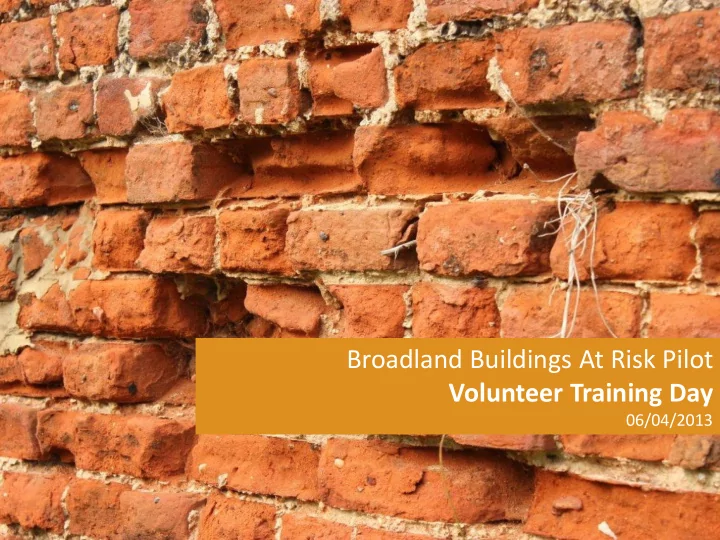

Broadland Buildings At Risk Pilot Volunteer Training Day 06/04/2013
Introduction
Introduction Who we are: • John Ette, English Heritage (EH) • Trudi Hughes, EH • Barbara Hornbrook, Broadland District Council (BDC) - mentor • Lynette Fawkes, BDC - mentor • Iain Soden, IS Heritage - mentor • Kate Pinnock, Ingham Pinnock Associates (IPA) • Ross Ingham, IPA
Introduction Housekeeping • Fire escapes • WCs • Refreshments
Introduction Programme for the day 11.15-11.45: Introduction to the pilot 11.45-12.30: Introduction to undertaking building at risk surveys 12.30-1.30: LUNCH 1.30-3.00: Group training sessions 3.00-3.15: Wrap up 3.15-4.00: BREAK 4.00-5.00: Lecture
Introduction What we would like you to take from today • Meeting your survey mentor • Meeting your survey partner • A better understanding of the pilot • A working knowledge of undertaking a building at risk survey
Background to the pilot
Background to the pilot Heritage at Risk Programme • The Grade II Listed buildings at risk pilots are part of the Heritage at Risk Programme • The Heritage at Risk Programme (HAR) was launched in 2008 by English Heritage, as a way of understanding the overall state of England's historic sites • The programme identifies those sites that are most at risk of being lost as a result of neglect, decay or inappropriate development
Background to the pilot Grade II Listed buildings at risk pilots • In Autumn 2012 EH announced it would like to progress a number of pilot studies looking at methods for establishing Grade II listed buildings at risk registers • EH maintains at risk registers for Grade I and Grade II* listed buildings (which make up only 8% of listed buildings), however, there is no standard risk register for Grade II listed buildings • English Heritage has chosen 19 pilots covering a range of areas, locations and types of survey method • The pilots commenced in February 2013 and will be completed by August 2013.
Background to the pilot Broadland buildings at risk pilot • Broadland District Council and Ingham Pinnock Associates were selected in January 2013 to undertake one of the 19 pilots • The pilot covers the Broadland District Council area • Although the pilots are concentrating on Grade II Listed buildings, the Broadland pilot will also include Grade I and II* Listed buildings • If the pilot is successful it could provide a template for a national roll out.
The Broadland Pilot
The Broadland pilot Overarching approach of the Broadland pilot: • To combine voluntary support with local authority knowledge and professional expertise
The Broadland pilot Broadland pilot objectives: • To establish a register of Grade II Listed buildings at risk in Broadland • To review the existing Grade I and II* Listed buildings at risk register for Broadland • To trial the use of volunteers in surveying buildings at risk • To use Town and Parish Councils’ local knowledge • To provide help and support for buildings that are identified as being at risk. It is important to remember this is a pilot! It is as much about what works as it is about what doesn’t work. We are all learning together!
The team structure
The team structure Scrutiny Panel: Includes the Core Team, Norfolk County Scrutiny Panel Council, English Heritage, BDC Economic Development and Planning teams and funding/heritage experts. Core Team: Barbara Hornbrook (BDC conservation), Lynette Core Team Fawkes (BDC conservation), Kate Pinnock (IPA) and Ross Ingham (IPA) Volunteers Volunteers: General public, history groups and Town and Parish Councils
The Process
The process Overarching process for Broadland pilot • Step 1: Establish pool of volunteers • Step 2: Establish a list of buildings to survey • Step 3: Carry out surveys • Step 4: Review buildings identified as potentially being at risk • Step 5: Compile the buildings at risk register • Step 6: Establish next steps for buildings at risk
The process Process for volunteers A) Attend training day B) Receive buildings for survey C) Select survey days D) Undertake survey (part 1) E) Submit survey to mentor F) Meet with mentor to review survey forms and establish whether a part 2 survey is required G) Attend final lecture
The rest of the day
The rest of the day Programme for the day 11.15-11.45: Introduction to the pilot 11.45-12.30: Introduction to undertaking building at risk surveys 12.30-1.30: LUNCH 1.30-3.00: Group training sessions 3.00-3.15: Wrap up 3.15-4.00: BREAK 4.00-5.00: Lecture
The rest of the day Purpose of introduction to undertaking buildings at risk surveys presentation (11.45- 12.30pm) • To illustrate what a building at risk is • To highlight how to identify a building at risk • To give an introduction to the survey form
The rest of the day Purpose of group training sessions (1.30-3.00pm) • Meet mentor • Review information packs • Equipment requirements • Guidance on undertaking surveys • Establish survey partner • An opportunity for you to ask questions.
The rest of the day You should all have: • Been allocated a training group (A,B, C or D) and mentor • Given an information pack • Given a high visibility jacket If you have not been given any of these things, please see Kate during lunch.
Recommend
More recommend